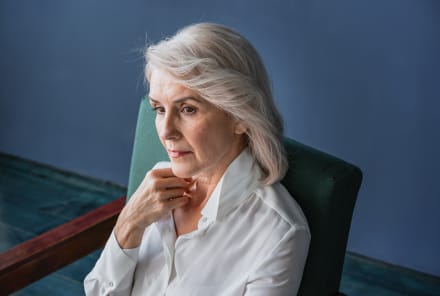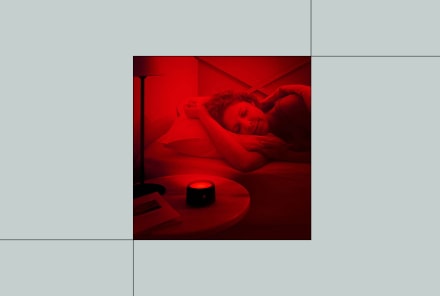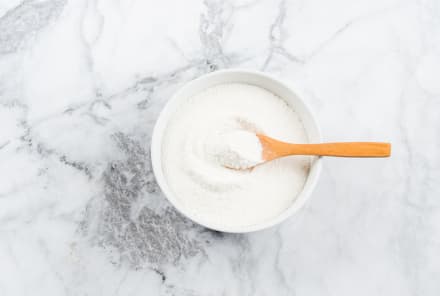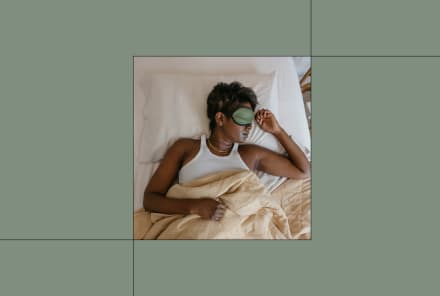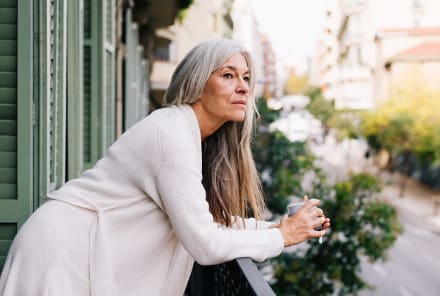Advertisement
What It's Like Living With A Rare Heart Condition As A Black Woman

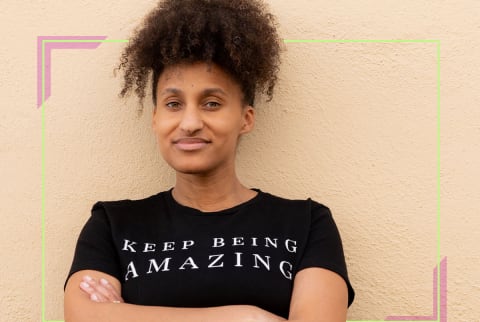
Trigger warning: This article includes mentions of suicidal ideation.
People often think a disability looks a certain way, without realizing there's so much more to it. That means someone who has an invisible illness has to have a certain amount of vulnerability to be seen.
My symptoms appeared out of nowhere.
Four years ago, I was on a plane en route to a family trip in Europe, when I started having heart flutters. I remember thinking "that's weird" since there weren't any altitude drops or signs of turbulence. As the child of a diplomat and an international lawyer, I'd traveled all over the world since I was young and never experienced anything like this. Then, during the trip, I started having intense night sweats, which didn't make any sense to me, either.
Toward the end of the trip, I was walking through a museum, when suddenly I had chest pains and it was hard to breathe. I sat down and then I was fine, but I had no idea what had happened. A couple of days later, I flew back home without any issues, so I didn't think much of it.
However, the day after I got back from the trip, I was relaxing on my couch recovering from jet lag, when I went into tachycardia (that's 100 beats per minute or higher while resting). I thought I was probably just dehydrated or tired.
The next day, I had a big client meeting for my company. On the drive, I started having intense chest pain again. Then, the pain started moving down my left arm. I pulled over and checked my heart rate, which was at 135 BPM.
I should note that I used to be premed, plus all of my degrees are in health. Based on that background, I immediately thought I was having heart attack symptoms. But it made no sense to me. I started going over my own clinical assessment: I had no cardiovascular problems at that time, no family history of cardiovascular issues; I didn't have high blood pressure. I determined I was probably dehydrated from traveling—so I got an electrolyte drink, went to my meeting, and scheduled a check-in with my health provider for the following week.
Then, I woke up the next morning with pain going down my arm again. When I called urgent care, they told me to call 911 and go to the emergency room immediately. But I was 34 at the time, I had no cardiovascular history, and I'm a Black woman—so I thought they weren't going to admit me. I ended up asking my neighbor to drive me to the ER, where all the tests came back inconclusive.
I faced a lot of discrimination in the health care system.
There's a lot of stigma when it comes to women and cardiovascular health1. It's often seen as a male-centric condition, and research has found that women are more likely to be considered low-risk for cardiovascular disease than men who show the same symptoms.
Providers aren't necessarily trained in the ways cardiovascular symptoms like strokes and heart attack can present for women and how they can differ from men's symptoms. For example, we can sweat, we can have a headache, we can have stomach pain (which they may mistake for cramps), in addition to the classic symptoms.
Being a Black woman dealing with these symptoms presents a whole new set of issues. For me, in my experience, speaking for Black people and Black women, there is an antiquated notion that Black people have a higher pain tolerance—this was a way to justify the brutal treatment of enslaved Black people in America. I get that we're going back to the 1600s with this history, but the same thinking still happens today2.
I remember on my third ER visit, I was in the same room as a white woman who was sent there for similar reasons. She was just a bit older than me, and we both had an irregular EKG. I remember hearing her doctors tell her that even though she had a history of panic attacks and anxiety, they were going to admit her, just to monitor her heart overnight.
Then, the doctor came over to me and told me they didn't know what was wrong, and they were going to discharge me. I remember telling him my pain level was an 8, knowing if it's 6 or 7 or higher, they have to manage your pain before they discharge you. After offering me Vicodin (even though I was wearing a bracelet that indicates I have an adverse reaction to it), he asked, "What do you want?" I ended up getting some pain medication and going home. I just remember crying because it felt like my life didn't matter at all. I literally wasn't seen, and I felt very disposable.
I have lots of stories like that, and I wish I didn't.
I was misdiagnosed multiple times before finding out what was wrong.
Fast-forward to my fourth ER visit: Doctors determined that I had pericarditis, which is the inflammation of the pericardium (the membrane enclosing the heart). That inflammation spread into my lungs, leading to costochondritis3 (inflammation of the cartilage that connects a rib to the breastbone). Then, I was told I also had plural pericarditis4, meaning my lungs were inflamed.
I was put on a medical regimen—then six to eight months later, they discovered I didn't have pericarditis, after all. The medication I was taking gave me duodenitis5 (inflammation of the duodenum), which means I can never take nonsteroidal anti-inflammatory drugs (NSAIDs) again for pain management.
I also was diagnosed with orthostatic hypotension—a sudden drop in blood pressure from standing—and I always live with low blood pressure (low blood pressure is 90/60, it's not uncommon for me to be 80/50-something). If I sit down for too long or if I stand for too long, my body, heart, and mind don't know how to regulate that.
To add to that, I was diagnosed with inappropriate sinus tachycardia (IST)6, so I go into tachycardia for no reason—along with premature atrial contractions (PACs)7, which feels like an extra heartbeat.
So I got this wide range of different diagnoses, but doctors still couldn't explain my chest pain.
It took about a year and a half, then I was finally diagnosed with coronary artery spasms. That means the arteries of my heart sometimes close—they literally spasm and close—and it mimics a heart attack. It essentially emulates a clogged artery—it'll close for anywhere from 30 seconds to 30 minutes, then it'll open up. All of that to say, I live with the symptoms of a heart attack: chronic pain from my jaw down to my stomach on my left side, weakness in my left arm from time to time, shortness of breath, and even swollen feet (let's just say I have a lot of Birkenstocks).
The terrifying thing is I could actually be having a heart attack, and I wouldn't know. Now, I have to carry nitroglycerin—which is what doctors give people when they're having a heart attack—with me wherever I go. I can take two of them, and if on the third one the spasm doesn't go away, then I have to go to the emergency room. That's what I'll have to do for the rest of my life.
How my invisible illness affects my daily life.
When I got my range of diagnoses, it literally changed my life. First and foremost, I can't have stress because it's an inducer for coronary artery spasms. I don't know about you, but I've never met anyone who lives a stress-free life—even if you're living your best life, there's always some stress.
The days of me going to a standing-only concert are gone. Airports are one of the worst places for me to be because airports are stressful, so I have to pre-board. And because I look healthy (hence, invisible illness), people always think I'm just being a privileged, spoiled young person. However, something as simple as standing in line to board a plane could cause me to pass out or have intense chest pain.
When I travel, I always have to know where an emergency room is, and I have to make sure I have coverage if I'm going out of the country, just in case I need care. The list goes on.
My invisible illness heightened my existing mental health challenges.
Two years before any of my physical health symptoms began, I was diagnosed with major depressive disorder by two different therapists. Initially, it was triggered as a result of being discriminated against in the workplace. I'd been getting better, but when I received my lifelong diagnosis, I went back into a very dark depression. From December 23 of that year to the first week in March, I was contemplating whether I wanted to live or not.
I scheduled a meeting with a new therapist ASAP. While I gave myself permission to be sad, I also started going to therapy once or twice a week for the next year. I had to learn how to live again.
In that time, I chose to embrace who I am—living in chronic pain, with an invisible illness. It's also important to acknowledge that invisible illness and disability and mental illness go hand in hand. From there, I had to figure out: How do I communicate this to my clients? How do I communicate it to the world?
I decided to do things the modern American way: I posted a picture on social media. I shared a picture of me wearing a heart monitor, along with my story. I knew that I could lose business, possibly friends—but I actually received so much love, which validated how important it is to be my true authentic self, embracing my invisible illness and disability.
My advice to anyone dealing with health challenges.
After my experience, I now do what I need to feel safe if I'm going to the emergency room. I know all of my patients' rights, and I only work with doctors who believe me. All of that protects my mental and physical health.
For anyone managing invisible illness, it's really important to know all the tricks for your own patient advocacy. These are my go-to tips for anyone facing similar challenges in the health care system:
- Do your own research: I highly recommend looking into your condition and symptoms, and learning what tests you'd like your doctor to try.
- Keep a paper trail: If your provider refuses to run a test or check something you ask for, ask them to note it in your chart.
- Record your session or take notes: Doctors will tell you a million things during your visit, and you'll often forget what they said. So ask if you can record the conversation, take notes, ask for summary notes, or have them write it down for you.
- Ask for clarification: Make sure you have a clear understanding of your results before you leave the doctor. This also helps with anxiety or stress that can come up.
- File a complaint: If you are living with a disability, by law, a hospital has to accommodate you—if they're not doing so, then you can file a complaint. If we're not filing the complaints, there's no way they know to improve or hold that person or department accountable.
- Fire people: If a health care provider doesn't believe anything about you, you should fire them. You are the expert of your own body, so if something is off, and they dismiss your symptoms, know that you can find someone much better.
- Bring backup: Have a friend or family member come with you to the doctor. I hate to say this, but sometimes I'll ask a white person to come with me—because if the doctors don't see me, they'll listen to that person.
As for support, I also can't emphasize enough how important it is to build or find your community. Whether it is a parent or friend or someone else who has something similar, just find that community. Because that isolation also affects the overall mental and physical health.
Now, I'm choosing to move forward and inspire others.
I'm always trying to find the positive in life. My mantra is "keep being amazing." I put it on a T-shirt, I sign my emails with it, and I tell people to keep being amazing.
Because, truly, my life is incredibly hard. I go to bed in pain; I wake up in pain. But I'm able to get out of bed, I'm able to lead my company, which advocates for underrepresented communities in the workplace, and I'm able to inspire hundreds of thousands of people. I think that's pretty great and powerful, and I'm really proud of myself for being able to do it. I manage my physical health, I manage my mental health, and I find ways to make it work for me.
So, I would tell anyone who's reading this article that they're worthy and deserve to celebrate all their victories, big and small. You really just have to keep being amazing.
7 Sources
- https://www.cdc.gov/heartdisease/women.htm
- https://www.ncbi.nlm.nih.gov/pmc/articles/PMC4843483/
- https://www.ncbi.nlm.nih.gov/books/NBK532931/
- https://www.ncbi.nlm.nih.gov/books/NBK431080/
- https://www.ncbi.nlm.nih.gov/pmc/articles/PMC5583440/
- https://www.ncbi.nlm.nih.gov/pmc/articles/PMC5872261/
- https://www.ncbi.nlm.nih.gov/books/NBK559204/
Watch Next
Enjoy some of our favorite clips from classes
Enjoy some of our favorite clips from classes
What Is Meditation?
Mindfulness/Spirituality | Light Watkins
Box Breathing
Mindfulness/Spirituality | Gwen Dittmar
What Breathwork Can Address
Mindfulness/Spirituality | Gwen Dittmar
The 8 Limbs of Yoga - What is Asana?
Yoga | Caley Alyssa
Two Standing Postures to Open Up Tight Hips
Yoga | Caley Alyssa
How Plants Can Optimize Athletic Performance
Nutrition | Rich Roll
What to Eat Before a Workout
Nutrition | Rich Roll
How Ayurveda Helps Us Navigate Modern Life
Nutrition | Sahara Rose
Messages About Love & Relationships
Love & Relationships | Esther Perel
Love Languages
Love & Relationships | Esther Perel
What Is Meditation?
Box Breathing
What Breathwork Can Address
The 8 Limbs of Yoga - What is Asana?
Two Standing Postures to Open Up Tight Hips
How Plants Can Optimize Athletic Performance
What to Eat Before a Workout
How Ayurveda Helps Us Navigate Modern Life
Messages About Love & Relationships
Love Languages
Advertisement

This Little-Known Supplement Helps Women Sleep & Decreases Signs Of Depression
Molly Knudsen, M.S., RDN

This Little-Known Supplement Helps Women Sleep & Decreases Signs Of Depression
Molly Knudsen, M.S., RDN


